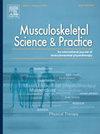“Go and get it checked”: Exploring the decision to attend the emergency department for low back pain
IF 2.2
3区 医学
Q1 REHABILITATION
引用次数: 0
Abstract
Purpose and background
Low back pain affects individuals and society, straining Emergency Departments (EDs) and prolonging wait times. While personal factors influence ED visits, third-party advice's role is underexplored. Limited guidance for healthcare professionals emphasises the need for effective back pain management to ease system strain and improve patient outcomes. This study examines motivations for ED visits due to low back pain.
Methods and results
This research utilised secondary analysis of qualitative data from a previous multisite study, adopting a subtle realist approach. From August to December 2021, 47 patients (26 M:21 F, aged 23–79) with back pain were sampled from four English EDs (2 Northern, 2 Southern) to capture diversity in sociodemographic and LBP characteristics. Eight patients had previously visited the ED for this back pain episode. During the pandemic, semi-structured interviews were conducted online, audio-recorded, transcribed, and analysed thematically.
Three key themes influenced decisions to attend ED: Healthcare professionals, trusted others, and individuals. Healthcare professionals often dictated choices, making participants feel powerless. Trusted others offered varying support, acting as allies. Individuals wrestled with anxiety about pain severity and uncertainty regarding LBP.
Conclusion
This study emphasises the need for healthcare professionals to offer clear guidance on when individuals and their caregivers should visit the ED for back pain. Findings show that pain-related worries significantly drive ED visits, misaligning with practice guidelines. Healthcare providers must consider these issues when creating strategies to manage low back pain patients and optimise ED resources.

“去检查一下”:探讨下腰痛去急诊室的决定
目的和背景腰痛影响个人和社会,使急诊科(ed)紧张并延长等待时间。虽然个人因素会影响急诊室就诊,但第三方建议的作用尚未得到充分探讨。有限的指导卫生保健专业人员强调需要有效的背部疼痛管理,以缓解系统紧张和改善病人的结果。本研究考察了因腰痛而去急诊室就诊的动机。方法和结果本研究采用了一种微妙的现实主义方法,对先前多地点研究的定性数据进行了二次分析。从2021年8月至12月,从4个英国急诊室(2个北部,2个南部)抽取47名背痛患者(26名男性:21名女性,年龄23-79岁),以捕捉社会人口统计学和腰痛特征的多样性。此前有8名患者曾因背痛来过急诊科。在大流行期间,进行了在线、录音、转录和专题分析的半结构化访谈。三个关键主题影响了参加ED的决定:医疗保健专业人员、可信任的其他人和个人。医疗保健专业人员经常发号施令,让参与者感到无能为力。值得信任的人提供了不同的支持,就像盟友一样。个体对疼痛的严重程度和LBP的不确定性感到焦虑。结论:本研究强调了医疗保健专业人员对个人及其护理人员何时因背痛而去急诊室提供明确指导的必要性。研究结果表明,与疼痛相关的担忧在很大程度上推动了急诊科的就诊,这与实践指南不符。医疗保健提供者在制定管理腰痛患者和优化ED资源的策略时必须考虑这些问题。
本文章由计算机程序翻译,如有差异,请以英文原文为准。
求助全文
约1分钟内获得全文
求助全文
来源期刊

Musculoskeletal Science and Practice
Health Professions-Physical Therapy, Sports Therapy and Rehabilitation
CiteScore
4.10
自引率
8.70%
发文量
152
审稿时长
48 days
期刊介绍:
Musculoskeletal Science & Practice, international journal of musculoskeletal physiotherapy, is a peer-reviewed international journal (previously Manual Therapy), publishing high quality original research, review and Masterclass articles that contribute to improving the clinical understanding of appropriate care processes for musculoskeletal disorders. The journal publishes articles that influence or add to the body of evidence on diagnostic and therapeutic processes, patient centered care, guidelines for musculoskeletal therapeutics and theoretical models that support developments in assessment, diagnosis, clinical reasoning and interventions.
 求助内容:
求助内容: 应助结果提醒方式:
应助结果提醒方式:


